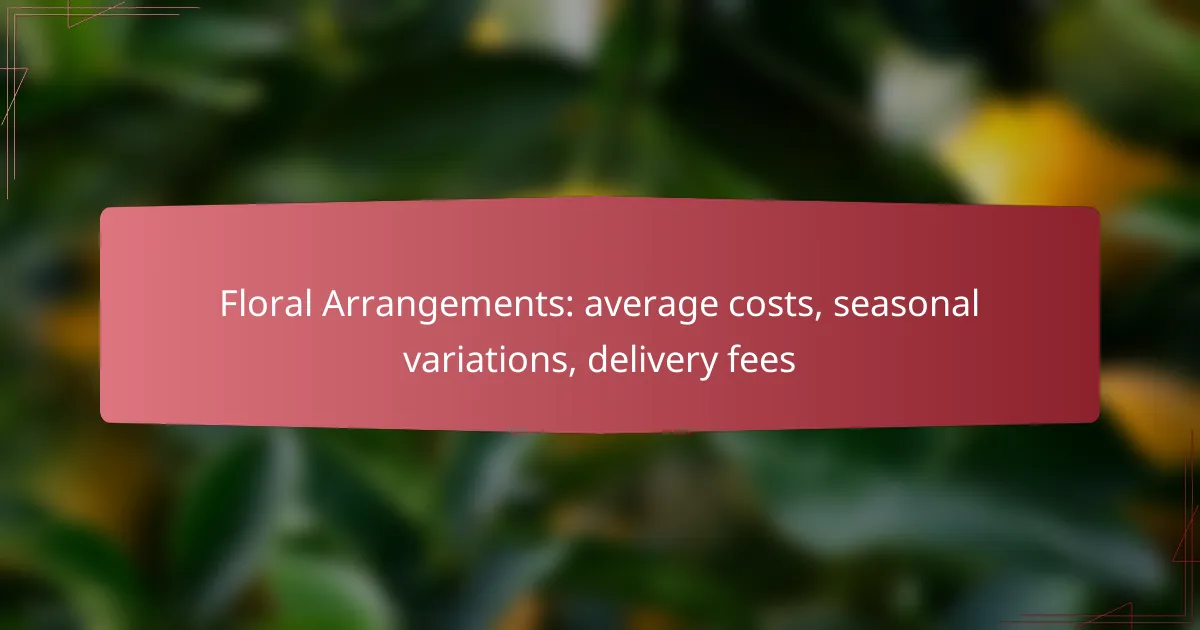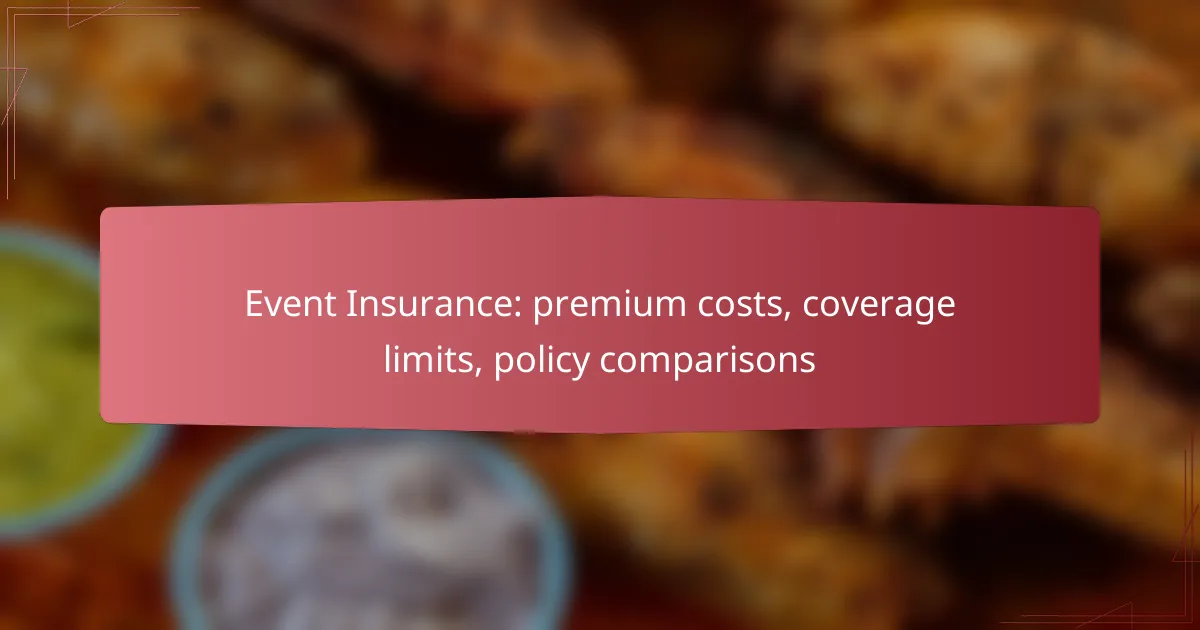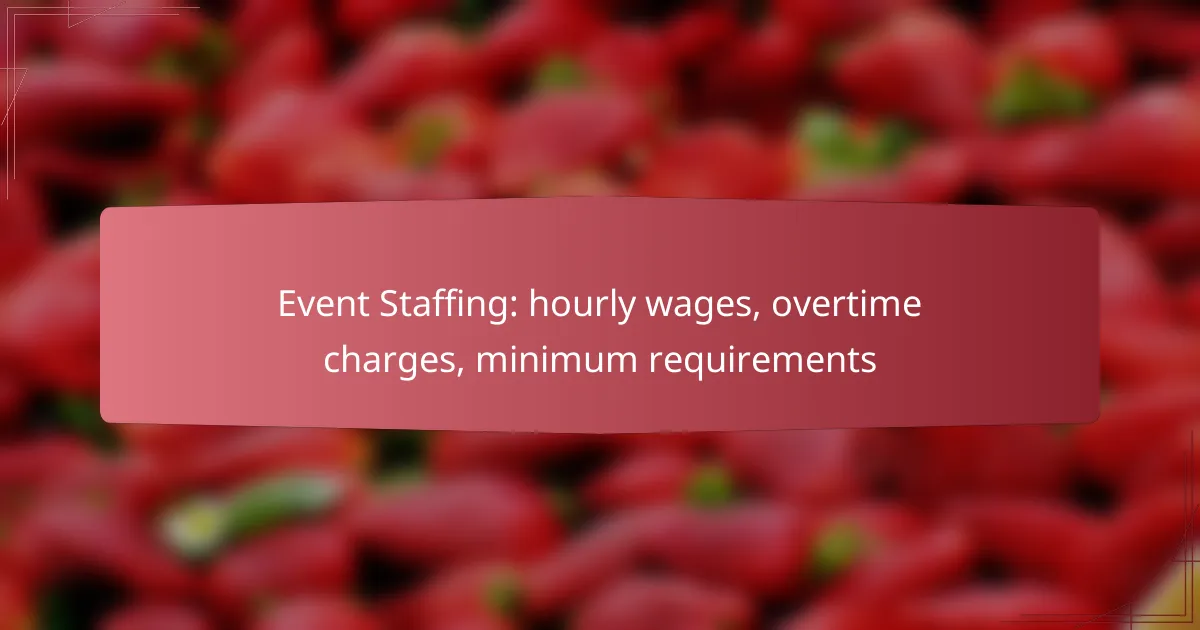When planning to purchase floral arrangements, it’s important to consider the average costs, which typically range from £30 to £100 based on the arrangement’s complexity. Seasonal variations can significantly affect pricing, as the availability and demand for flowers fluctuate throughout the year. Additionally, delivery fees, usually between £5 and £15, can further influence the total expense, depending on distance and service type.
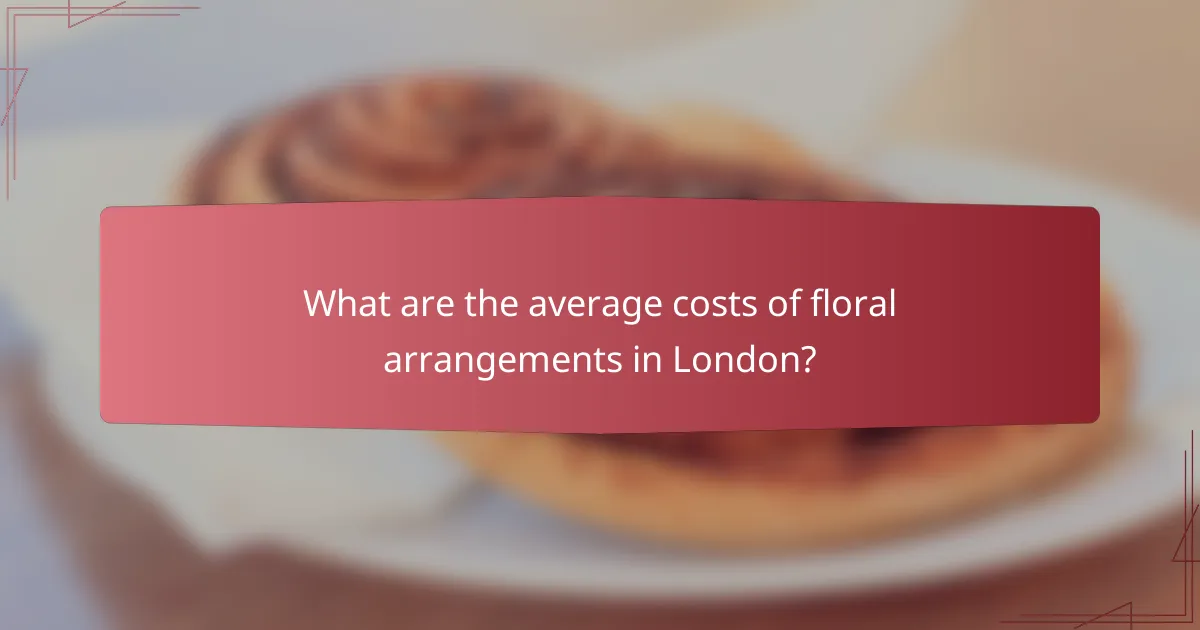
What are the average costs of floral arrangements in London?
The average costs of floral arrangements in London typically range from £30 to £100, depending on the type and complexity of the arrangement. Seasonal variations and delivery fees can also impact the final price, making it essential to consider these factors when budgeting for flowers.
Standard bouquet costs
Standard bouquets in London usually start at around £30 and can go up to £60 for more elaborate designs. These arrangements often include a mix of seasonal flowers and greenery, making them suitable for various occasions like birthdays or anniversaries.
Common examples of standard bouquets include simple hand-tied arrangements or mixed flower bunches, which are widely available at local florists and online retailers. Prices may vary based on the florist’s reputation and the specific flowers used.
Luxury arrangements pricing
Luxury floral arrangements in London can range from £100 to £300 or more, depending on the intricacy and the types of flowers included. High-end options often feature exotic blooms, unique designs, and premium packaging, making them ideal for special events or corporate gifts.
Florists may offer bespoke services for luxury arrangements, allowing customers to customize their orders. This personalization can significantly influence the price, so it’s advisable to discuss options and budgets upfront.
Factors influencing costs
Several factors influence the costs of floral arrangements in London, including flower type, seasonality, and arrangement complexity. Seasonal flowers tend to be more affordable, while out-of-season blooms can drive up prices due to import costs.
Additionally, delivery fees can vary based on distance and urgency. Many florists charge a flat rate for local deliveries, while same-day service may incur higher fees. Always check delivery policies to avoid unexpected costs.
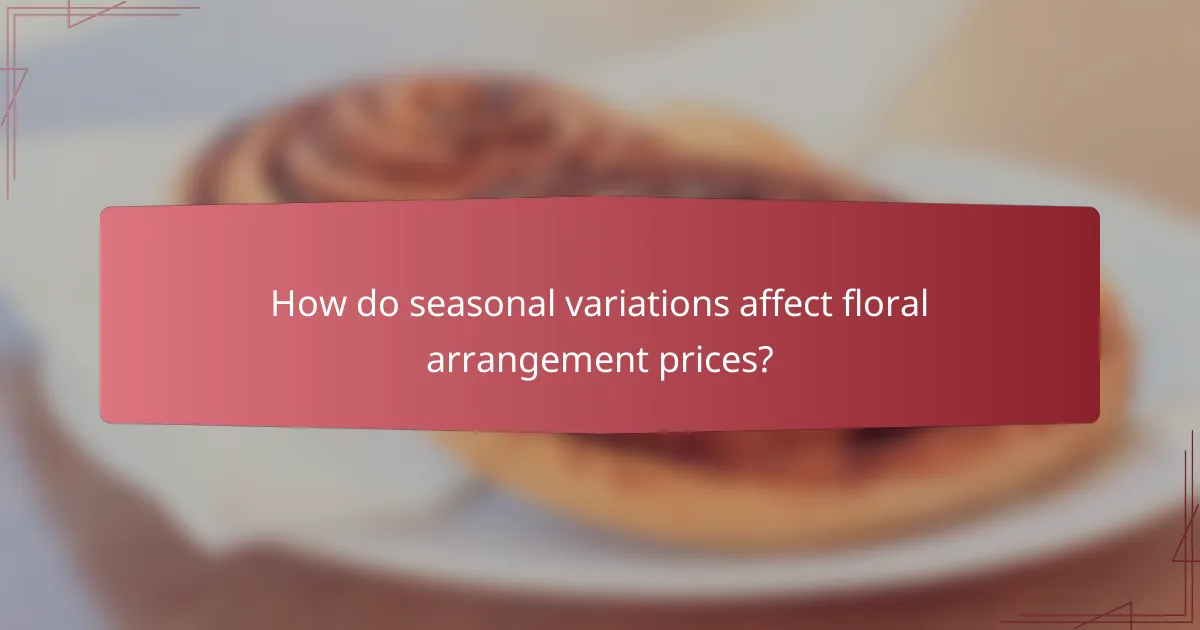
How do seasonal variations affect floral arrangement prices?
Seasonal variations significantly influence floral arrangement prices due to the availability and demand for specific flowers throughout the year. Prices tend to rise during peak seasons when certain blooms are in high demand, while off-season flowers may be more expensive due to import costs.
Spring flower pricing trends
In spring, floral arrangement prices generally decrease as many flowers, such as tulips and daffodils, are in season and widely available. This season typically sees a surge in demand for arrangements for events like Easter and Mother’s Day, which can lead to slight price increases during these peak times.
Florists often offer promotions or discounts on spring arrangements to attract customers, making it a cost-effective time to purchase flowers. Expect prices to range from moderate to low, depending on the specific flowers chosen and the complexity of the arrangement.
Summer floral costs
Summer brings a diverse array of flowers, including sunflowers and roses, which can lead to fluctuating prices. While many flowers are abundant during this season, the demand for weddings and outdoor events can drive prices up, especially for popular varieties.
On average, floral arrangements in summer may be priced slightly higher than in spring, often falling within the mid-range. It’s advisable to book arrangements early to secure better rates and availability, especially for peak wedding months.
Autumn and winter price fluctuations
During autumn, prices can vary as some flowers, like chrysanthemums and asters, come into season, while others become scarce. The demand for arrangements for holidays such as Halloween and Thanksgiving can lead to increased prices, particularly for themed arrangements.
Winter often sees the highest costs due to the limited availability of fresh flowers, with many florists relying on imports. Prices for arrangements can be significantly higher, especially around major holidays like Christmas and Valentine’s Day, where demand peaks. Budgeting for floral arrangements during these months should account for these seasonal price hikes.
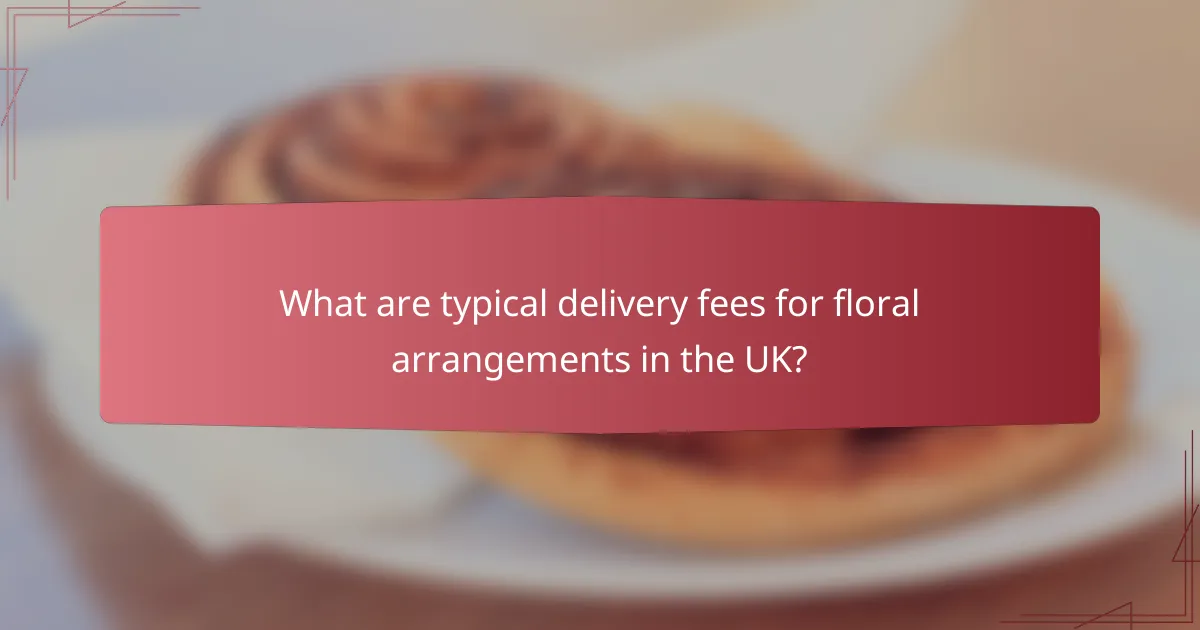
What are typical delivery fees for floral arrangements in the UK?
Delivery fees for floral arrangements in the UK can vary significantly based on factors like distance, service type, and the florist’s policies. Generally, customers can expect to pay anywhere from £5 to £15 for standard delivery, with additional costs for expedited services.
Standard delivery charges
Standard delivery charges for floral arrangements typically range from £5 to £10 within most urban areas in the UK. This fee often covers delivery within a certain radius from the florist’s location, usually around 5 to 10 miles. For deliveries outside this range, additional fees may apply.
Some florists offer flat-rate delivery fees, while others may calculate charges based on distance. Always check the florist’s website or inquire directly for specific pricing details.
Same-day delivery costs
Same-day delivery for floral arrangements usually incurs higher fees, often ranging from £10 to £20. This premium is charged for the expedited service, which requires the florist to prepare and dispatch the arrangement quickly. Availability of same-day delivery may also depend on the time of order placement.
It’s advisable to place same-day orders early in the day to ensure timely delivery. Additionally, not all florists offer this service, so confirm with the florist beforehand.
Free delivery options
Some florists in the UK provide free delivery options, typically for orders over a certain amount, often around £30 to £50. This can be a cost-effective choice for customers looking to send larger arrangements or multiple items.
Additionally, promotional offers or loyalty programs may include free delivery as a perk. Always check for any current promotions that could apply to your order to save on delivery costs.
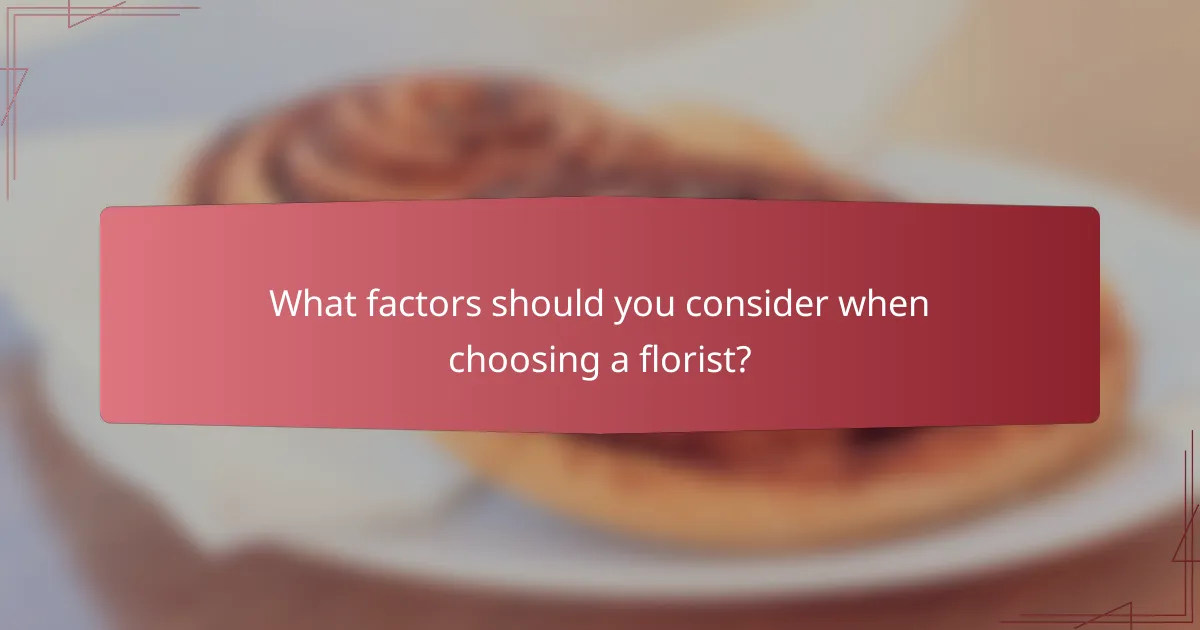
What factors should you consider when choosing a florist?
When choosing a florist, consider their reputation, delivery options, and customization capabilities. These factors can significantly impact your overall satisfaction with the floral arrangements and services you receive.
Reputation and reviews
A florist’s reputation is crucial when selecting a provider. Look for online reviews and testimonials from previous customers to gauge their reliability and quality of service. A florist with consistently positive feedback is more likely to meet your expectations.
Check for any awards or recognitions that the florist may have received, as these can indicate a level of professionalism and expertise. Additionally, consider asking friends or family for recommendations based on their experiences.
Delivery options
Delivery options can vary widely among florists, so it’s essential to understand what each provider offers. Some florists may provide same-day delivery, while others might require advance notice, especially during peak seasons like holidays.
Inquire about delivery fees, which can range from a few dollars to more substantial amounts depending on the distance and urgency. Ensure the florist can deliver to your desired location, whether it’s a home, office, or event venue.
Customization capabilities
Customization capabilities allow you to create a floral arrangement that meets your specific needs and preferences. Many florists offer personalized services, such as selecting particular flowers, colors, and styles to match your occasion.
Discuss your vision with the florist and ask about their ability to accommodate special requests. Some florists may also provide pre-designed options that can be tailored to your liking, giving you flexibility while ensuring quality.

How can you save on floral arrangements?
Saving on floral arrangements can be achieved through various strategies, including taking advantage of discounts, selecting seasonal flowers, and considering DIY options. By being mindful of these factors, you can significantly reduce costs while still enjoying beautiful blooms.
Discounts and promotions
Many florists offer discounts and promotions throughout the year, especially during holidays or special events. Subscribing to newsletters or following local florists on social media can keep you informed about upcoming sales and exclusive offers.
Additionally, consider purchasing flowers in bulk for events like weddings or parties, as many florists provide significant discounts for larger orders. Always ask about any available promotions before finalizing your purchase.
Choosing seasonal flowers
Selecting seasonal flowers is a practical way to save money on floral arrangements. Seasonal blooms are typically more abundant and less expensive than out-of-season varieties, which may require special sourcing.
For example, in spring, tulips and daffodils are often available at lower prices, while peonies are popular in late spring and early summer. Research local growing seasons to find the best options available in your area.
DIY arrangement tips
Creating your own floral arrangements can be a rewarding and cost-effective alternative to purchasing pre-made ones. Start by selecting a few key flowers and greenery that complement each other, and use simple tools like floral foam or wire to structure your arrangement.
Consider watching online tutorials or taking a local workshop to learn basic techniques. This not only saves money but also allows for personalization, making your arrangements unique to your style and occasion.
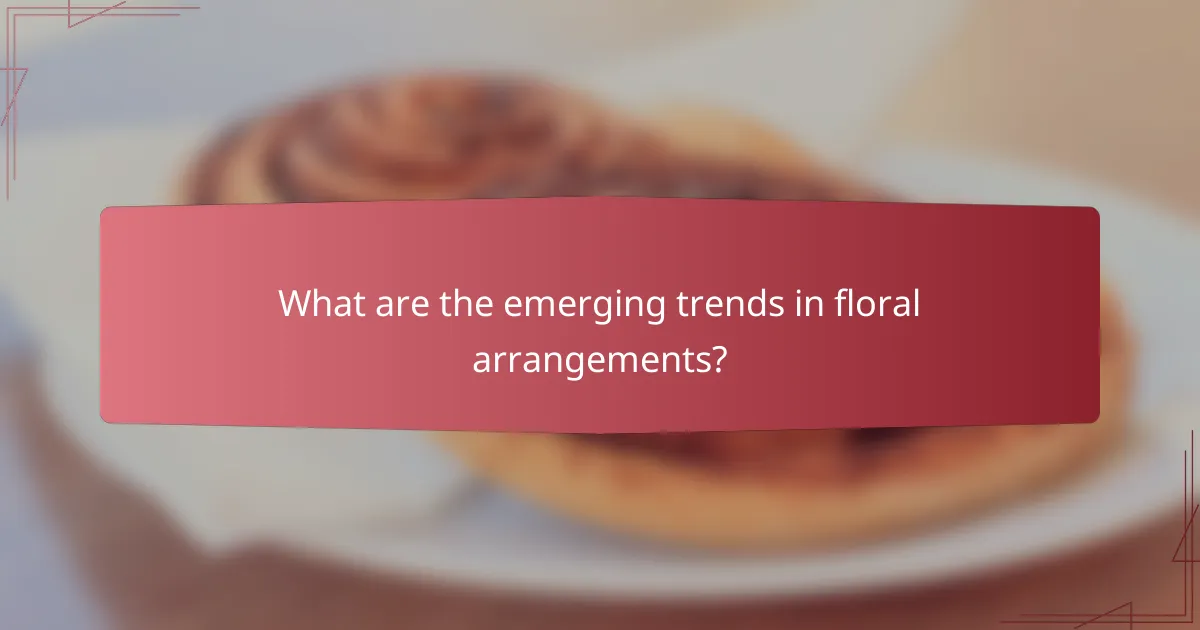
What are the emerging trends in floral arrangements?
Emerging trends in floral arrangements focus on sustainability, minimalism, and personalization. These trends reflect a growing consumer preference for eco-friendly practices and unique designs that resonate with individual tastes.
Sustainable sourcing practices
Sustainable sourcing practices in floral arrangements prioritize the use of locally grown flowers and environmentally friendly farming methods. This approach reduces carbon footprints and supports local economies, making it a popular choice among eco-conscious consumers.
When selecting flowers, consider those that are in season and sourced from sustainable farms. Look for certifications like Fair Trade or organic labels to ensure ethical practices. This not only benefits the environment but often results in fresher, longer-lasting blooms.
Minimalist designs
Minimalist designs emphasize simplicity and elegance, often featuring fewer flowers with a focus on texture and form. This trend appeals to those seeking a clean aesthetic, making it suitable for modern events and home decor.
To create a minimalist floral arrangement, choose a limited color palette and select a few statement flowers. Incorporate greenery or unique vessels to add interest without overwhelming the design. This approach can also be cost-effective, as it often requires fewer materials.
